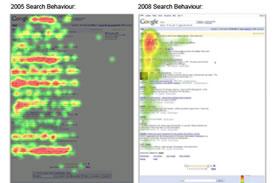What are you looking at? Eye Tracking can help your content be more effective.
My favorite type of data in the world of user interface design/user experience is Eye Tracking. An Eye Tracking study tells us where people look. It can tell us the order that information is scanned and it can display a heat map to show where a sample of web visitors looked on your web page. Eye Tracking can be used for web content, print media, product packaging and anything else where you want to measure what is being seen.
The image to the right shows the difference in search behavior from 2005 to 2008. The data shows that people have learned to scan Google and not read every item.
How do they do it?
In the old days you had to wear a really complicated helmet that had sensors to watch your eyes and track their movement. In today's world, they can set up a special camera to track your eye movement. There is even a company with the cool ability to use your computer's webcam to track eye movement.
How can you use it?
Eye Tracking can be a valuable tool to help plan the layout of a web design. Mashable recently asked EyeTrackShop to evaluate Facebook Brand pages. If you have a Facebook page for your business, or you plan to have one this year, this is an interesting read to plan for the most effective use of Facebook.
At a high level, they learned that:
- Content matters because page visitors spend the most time viewing the wall
- Profile photos with faces get the most attention
- Photos in your posts get attention
Go check out the study and then I'd love to hear what you think.
Image credit: Monty Metzger
MONTHLY MARKETING INSIGHTS.
Get thought-provoking and actionable insights to improve how your firm makes a connection with your customers.





LEAVE A COMMENT